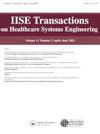风险规避多阶段随机规划优化疫苗分配和治疗物流以有效应对疫情
IF 1.5
Q3 HEALTH CARE SCIENCES & SERVICES
IISE Transactions on Healthcare Systems Engineering
Pub Date : 2021-05-28
DOI:10.1080/24725579.2021.1938298
引用次数: 14
摘要
现有流行病控制中的分区物流模型在风险规避目标下优化疫苗和治疗资源配置方面存在局限性。在本文中,我们提出了一个数据驱动、平均风险、多阶段、随机流行病疫苗接种物流模型,该模型在条件风险值(CVaR)风险度量下评估各种疾病增长情景,以优化治疗中心、资源和疫苗的分配,同时在有限的预算下最小化感染、死亡和感染者密切接触者的总预期人数。我们将一个新的环形疫苗接种室整合到易感-感染-治疗-康复-葬礼-埋葬流行病-物流模型中。我们的配方涉及疫苗供应和疾病传播率的不确定性。在这里,我们还考虑了由于疫情导致的感染和死亡人数方面导致不良后果的情况的风险。将风险中性目标与风险度量相结合,可以在疫情的加权预期影响和与经历极端灾难性情景相关的预期风险之间进行权衡。我们将人口流动纳入模型,并开发了一种新的方法来估计在迁移率数据不可用时每个地区之间的迁移率。我们将多阶段随机混合整数规划模型应用于刚果民主共和国(DRC)控制2018-2020年埃博拉病毒病(EVD)的实际数据。我们的研究结果表明,通过强调潜在的灾难性爆发情景来增加风险规避,以增加所有可能情景的预期感染和死亡人数为代价,降低了与不利情景相关的预期风险。我们还发现,隔离和治疗受感染的个人是减缓疾病传播的最有效方法,而疫苗接种是减少感染人数的初级干预措施的补充。此外,我们的分析表明,在疫苗供应紧张的情况下,疫苗接受率仅在疫苗推广的初始阶段影响最佳疫苗分配。本文章由计算机程序翻译,如有差异,请以英文原文为准。
Risk-averse multi-stage stochastic programming to optimizing vaccine allocation and treatment logistics for effective epidemic response
Abstract Existing compartmental-logistics models in epidemics control are limited in terms of optimizing the allocation of vaccines and treatment resources under a risk-averse objective. In this paper, we present a data-driven, mean-risk, multi-stage, stochastic epidemics-vaccination-logistics model that evaluates various disease growth scenarios under the Conditional Value-at-Risk (CVaR) risk measure to optimize the distribution of treatment centers, resources, and vaccines, while minimizing the total expected number of infections, deaths, and close contacts of infected people under a limited budget. We integrate a new ring vaccination compartment into a Susceptible-Infected-Treated-Recovered-Funeral-Burial epidemics-logistics model. Our formulation involves uncertainty both in the vaccine supply and the disease transmission rate. Here, we also consider the risk of experiencing scenarios that lead to adverse outcomes in terms of the number of infected and dead people due to the epidemic. Combining the risk-neutral objective with a risk measure allows for a tradeoff between the weighted expected impact of the outbreak and the expected risks associated with experiencing extremely disastrous scenarios. We incorporate human mobility into the model and develop a new method to estimate the migration rate between each region when data on migration rates is not available. We apply our multi-stage stochastic mixed-integer programming model to the case of controlling the 2018–2020 Ebola Virus Disease (EVD) in the Democratic Republic of the Congo (DRC) using real data. Our results show that increasing the risk-aversion by emphasizing potentially disastrous outbreak scenarios reduces the expected risk related to adverse scenarios at the price of the increased expected number of infections and deaths over all possible scenarios. We also find that isolating and treating infected individuals are the most efficient ways to slow the transmission of the disease, while vaccination is supplementary to primary interventions on reducing the number of infections. Furthermore, our analysis indicates that vaccine acceptance rates affect the optimal vaccine allocation only at the initial stages of the vaccine rollout under a tight vaccine supply.
求助全文
通过发布文献求助,成功后即可免费获取论文全文。
去求助
来源期刊

IISE Transactions on Healthcare Systems Engineering
Social Sciences-Safety Research
CiteScore
3.10
自引率
0.00%
发文量
19
期刊介绍:
IISE Transactions on Healthcare Systems Engineering aims to foster the healthcare systems community by publishing high quality papers that have a strong methodological focus and direct applicability to healthcare systems. Published quarterly, the journal supports research that explores: · Healthcare Operations Management · Medical Decision Making · Socio-Technical Systems Analysis related to healthcare · Quality Engineering · Healthcare Informatics · Healthcare Policy We are looking forward to accepting submissions that document the development and use of industrial and systems engineering tools and techniques including: · Healthcare operations research · Healthcare statistics · Healthcare information systems · Healthcare work measurement · Human factors/ergonomics applied to healthcare systems Research that explores the integration of these tools and techniques with those from other engineering and medical disciplines are also featured. We encourage the submission of clinical notes, or practice notes, to show the impact of contributions that will be published. We also encourage authors to collect an impact statement from their clinical partners to show the impact of research in the clinical practices.
 求助内容:
求助内容: 应助结果提醒方式:
应助结果提醒方式:


